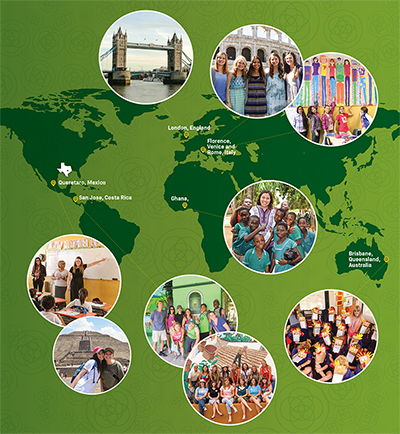Expanding Horizons - SOE Study Abroad
In 1988, the SOE added an international teaching component to its program by sending five undergraduates to teach in England for four weeks. A second destination was added eight years later when Assistant Professor Betty Ruth Baker expanded the program into Australia. Today, study abroad trips, either for credit or mission trips, are a robust and growing part of the SOE experience.
In 2017, the SOE launched the Carpenter Embedded Global Classroom, Baylor’s first fully funded study-abroad embedded classroom for future educators made possible through a gift from Don and Janette Carpenter. The one-week Queretaro, Mexico, trip taken during spring break is embedded as part of the required course in “Social Issues in Education” and includes experiences in different types of Mexican schools.
Undergraduates may choose to practice teach in Australia, England, Mexico or Costa Rica, while graduate students may further their studies and research in Costa Rica and Italy. Other trips to Ghana, Kenya or Costa Rica take students abroad for mission work. The Costa Rica spring break trip was founded by the SOE more than a decade ago.
“Each country has very different classroom structures and teaching pedagogies, and I believe that it is important to be globally and culturally aware in our increasingly diverse society,” said Jordan Ng, a junior Elementary Education major with a concentration in gifted and talented education. “Studying education abroad gave me the opportunity to experience and learn from other education systems, as well as to be able to apply that knowledge with students when we came back.”
As part of the senior intern experience in Australia, students spend three weeks assisting with research, classroom instruction and lessons on American culture. The Thanksgiving feast is always a favorite for the Baylor students and Aussies alike.
The London intern experience is structured similarly, with students teaching three weeks in the London suburbs of Kingston-Upon-Thames and Surbiton. Interns immerse themselves in the English schools and communities, teaching alongside British mentor teachers and participating in comparative international education seminars and professional development.
Baylor students studying methods of teaching English as a Second Language (ESL) may travel to San Jose, Costa Rica, for a month in the summer and stay with host families. They spend mornings at Saint Anthony School, a dual-language, K-12 school; afternoons are dedicated to course seminars and activities at the National University.
During a May mini semester, graduate students can earn three hours of credit in Costa Rica for a course on cultural issues with children and families. The class takes place on the southern Osa Peninsula region in the Corcovado tropical rain forest and in the Central Valley (San Jose). In both regions, students are exposed to contrasts in culture, schools, social services and economic conditions. Students interact with school children and teachers and conduct research alongside faculty and Costa Rican graduate students.
“The many memories made in Costa Rica with my mentor, Dr. Saxon, and fellow classmates were that of spiritual, personal and professional growth,” recalled Dr. Shanna Poyner Attai, who participated in 2014.
Finally, master’s and doctoral students visit schools in Florence and other Italian cities during a mini semester that offers three credit hours. While there, participants work in schools and spend time seeing sites such as the Vatican, Michelangelo’s David, and the canals of Venice.
“Several extremely unique school systems originated in Italy — Montessori, Pestalozzi and Reggio Emilia,” said Jamie Wong, BSEd ’18, MSEd ’19. “I looked forward to seeing how this student-centered approach to education shapes the students and the way their society works. Several Waco schools take inspiration from the Montessori model, so it was neat to see the similarities and differences.”
Other Baylor education-focused mission trips to Ghana, Kenya and Costa Rica are open to all students. Students work alongside teachers at local schools and engage in community development activities. Lessons on wellness and oral hygiene are taught, too.
“Costa Rica elementary classrooms allow much more freedom and movement than American schools,” said Abigail Traylor, a senior Elementary Education major. “I would like to include some of that in my classroom. Little children need to move often, and I would like to bring that back to America by having my own students participate actively in kinesthetic learning to be able to understand everything that is taught in a full school day.”
